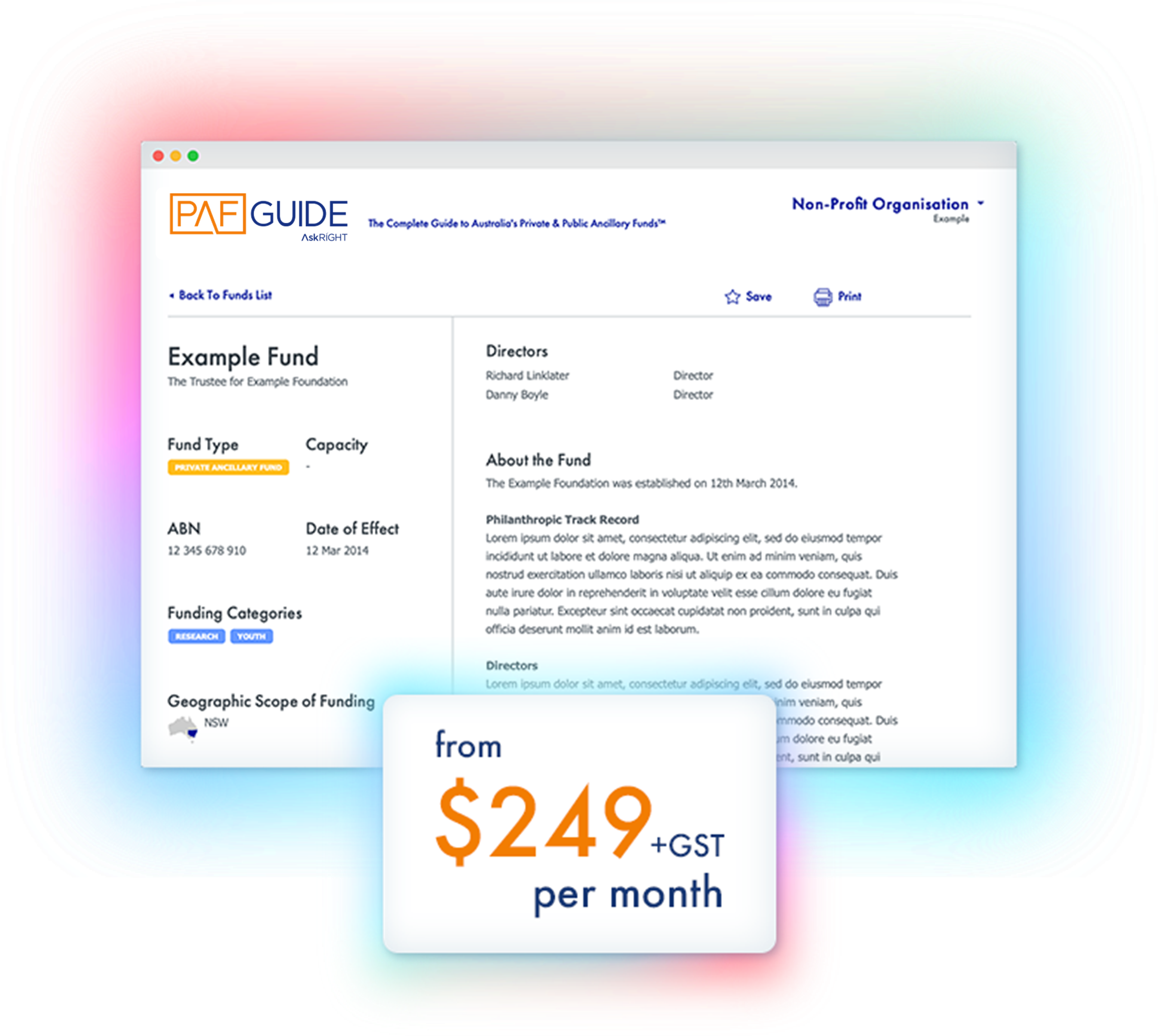BY CHLOE MARKS
Last April, as the charity sector started to feel the impact of the COVID-19 pandemic on services and fundraising, JBWere released ‘Where to from here? The outlook for philanthropy during COVID-19‘. The report used past trends to estimate the effect of a global health and economic crisis across the main types of philanthropy in Australia, including Private Ancillary Funds (PAFs):
One of the effects of COVID-19’s economic impact is likely to be the rate of establishment of new PAFs which may slow considerably in 2020 and 2021.
AskRIGHT conducted research into every identified PAF that was established in 2020 and, while it may be too soon to understand the full impact of COVID-19 on existing PAFs, the available data for the new PAFs might indicate what to expect in the coming years from this particular type of structured philanthropy in Australia.
NUMBER OF NEW PAFS
The total number of new PAFs established in 2020 (83) was down by 30% when compared to 2019 (119), and a further decrease when compared to the previous years:

Source: ABR data
As in previous years, the majority of the new PAFs were established in the months leading up to June, but there was less growth in March, presumably due to uncertainty and caution as a result of the pandemic:
 Source: ABR data
Source: ABR data
NATURE OF NEW PAFS
It is recommended that PAFs start with a minimum of $1 million and they must distribute at least 5% of the net assets or $11,000 (whichever is greater) during each financial year, but they are not required to distribute during the first year of establishment.
Unless, like some Public Ancillary Funds (PuAFs), the PAF was established as a charity for many years prior to the endorsement as a DGR 2 entity, there is no history or initial activity to discover.
Further, if a PAF is registered with ACNC they can request for information to be withheld or removed from the ACNC Charity Register. Of the new PAFs established in 2020, over half appear in the ACNC Charity Register:
 Source: ACNC dataset
Source: ACNC dataset
For the PAFs that appear in the ACNC Charity Register (53), the contact details, responsible people, funding categories and regions, and governing document is usually available; however, the size, which is based on annual revenue, is largely unknown:
 Source: ACNC dataset
Source: ACNC dataset
WHO, WHAT, WHEN, AND WHERE
Of the new PAFs established in 2020, the majority are registered in New South Wales (40%) and Victoria (27%), followed by South Australia (14%), Queensland (11%), Western Australia (7%), and Tasmania (1%), with no PAFs registered in Northern Territory or Australian Capital Territory:
 Source: ABR data
Source: ABR data
It is important to note that the registered location of the PAF might differ from where they operate, particularly for PAFs that are professionally managed. For example, Micah Enterprises WA, as a client of Australian Philanthropic Services (APS), is registered in New South Wales yet operates in Western Australia. The graph below, which includes 12 funds that operate Australia-wide, shows that, while New South Wales still has the greatest number of PAFs, the number is far more evenly distributed across all states and territories:
 Source: ACNC dataset
Source: ACNC dataset
Around 30% of the new PAFs are professionally managed, with the majority of these (over 60%) managed by APS:
 Source: ABR data & ASIC data
Source: ABR data & ASIC data
The cause or causes the PAF aims to support is largely unknown for new PAFs, with the majority indicating support of the general community:
 Source: ACNC dataset
Source: ACNC dataset
AskRIGHT research into each individual new PAF in 2020 reveals more specific funding categories, with Welfare, Health, Medical, and Youth as the leading categories:
 Source: PAFGUIDE Research
Source: PAFGUIDE Research
As there is often no charitable activity or giving history for new PAFs, it is important to look to the individual Directors to discover their personal giving history and indicators of wealth: Read Part 2 here.
MORE INFORMATION ON PAFS
Many not-for-profit organisations do not have the capacity to conduct the time-consuming and costly research required to find information on Private Ancillary Funds. ABN Lookup and ACNC Charity Register are useful to confirm whether an entity is a Private or Public Ancillary Fund (DGR 2) and to find some information, but these and other sources neither have the level of information required nor the functionality to search, filter, and favourite.
The AskRIGHT PafGUIDE® is the only online database containing every single Private Ancillary Fund, as well as Public Ancillary Funds (PuAFs), which are individually and comprehensively researched by the AskRIGHT Research Team. There is a text search bar, a number of filters, and useful features that help you to keep track of funds as prospects for your organisation. Learn more.
Start a 7-day Free Trial (no payment details required) or sign-up for 12 months of full access. Click here.
References
- https://www.jbwere.com.au/content/dam/jbwere/documents/Insights/where-to-from-here-the-outlook-for-philanthropy-during-covid-19-pdf.pdf
- https://www.australianphilanthropicservices.com.au/wp-content/uploads/2021/05/APS-PAF-brochure.pdf
- https://www.legislation.gov.au/Details/F2020C00522
- https://www.acnc.gov.au/tools/guidance/guides/private-and-public-ancillary-funds-and-acnc
- *McGregor-Lowndes, Myles, Balczun, Marie & Williamson, Alexandra (2021) Ancillary Funds 2000- 2019. ACPNS Current Issues Information Sheet 2021/1. Australian Centre for Philanthropy and Nonprofit Studies, QUT https://eprints.qut.edu.au/211850/
- https://app.pafguide.com.au/
*Data from this report was not used for this article, as it relies on tax statistics and therefore lags by a few years; however, it is important to recognise the excellent work of Australian Centre for Philanthropy and Nonprofit Studies (ACPNS).

